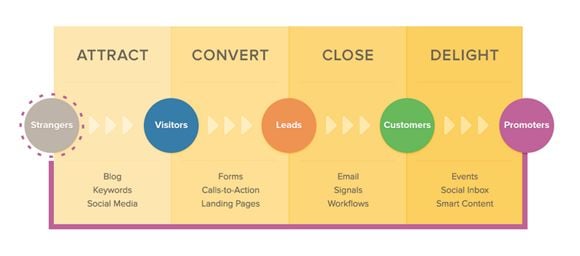Inbound Marketing Vs. Outbound Marketing
Katelyn Ahern Digital Project Manager#Digital Marketing, #Inbound Marketing

Learn why Inbound Marketing is a better solution for reaching customers than outdated outbound marketing techniques like cold calling and mass mailings.
Do you remember back in the day when you would sit down to dinner and the phone would inevitably start ringing? As a kid, you would beg to answer the phone, thinking it must be a family member or one of your friends. As a parent, you would cringe at the idea that anyone could possibly think this was an okay time to call your house. It felt like nine times out of ten it was a telemarketer calling to sell you something or survey you on some topic that had nothing to do with you.
You may have even experienced this in the past couple of weeks as we approached the latest election, but now the calls come to your cell phone instead of your house phone. This blatant interruption of your time has to stop. This outbound marketing tactic is outdated, and the fact that it still takes place is even more frustrating, given that marketers now have the ability to learn more than ever about potential consumers. Why do so many marketers waste their time on cold calls when they can use the information they have about their potential customers to target their efforts so much more efficiently? This frustration was the inspiration for inbound marketing.
But how exactly does inbound marketing differ from outbound marketing? Let's go over the differences between the two methods:
Outbound Marketing
Outbound Marketing typically consists of things like:
- Cold-calling
- TV Ads
- Direct Mail
- Pop up ads
- Paid email lists
The problem with using these strategies is that most of the time, they end up interrupting your audience (possibly during dinner), frustrating them before you even start talking, and ultimately not driving results. It's 2014, and it is time we start using our resources to enhance the customer experience rather than disturb people.
Inbound Marketing
Inbound Marketing typically consists of things like:
- Webinars
- Search Engine Optimization
- Opt in emails
- Podcasts
- eBooks
- Blogs
- Social media
- Videos
The idea behind inbound marketing is to deliver useful and relevant content to the right audience at the right time, ultimately helping your audience accomplish their goals. Doing this takes a lot of planning and hard work in order to get the formula just right for your particular audience, but the Inbound Marketing Methodology from HubSpot breaks it down into several different sections.

You can about the stages of the Inbound Marketing Methodology here, but the important takeaway is that Inbound Marketing allows you to use your expertise and the information that you’ve gathered about your audience to target your efforts toward people who are more likely to become customers. Doing so will not only increase the efficiency of your marketing efforts, it will help you understand your audience’s needs and how you can best solve their problems and form lasting customer relationships. If you have further questions on how to use this Marketing Methodology for your audience, feel free to reach out to a Diagram Marketing Specialist.
The Value of Inbound
The main thing to keep in mind when you are implementing inbound marketing is that these are foundational changes that are then tailored to help you reach your goals, while also providing value to your audience. Your primary goal is to deliver value and relevant information to your audience. Because inbound marketing is focused more on delight than disruption, this leads to 54% more leads than traditional outbound marketing. Also, keep in mind that getting the mix of the right content at the right time has led to inbound leads costing 61% less than outbound leads!
While I am a huge fan of inbound marketing, I think it’s important to note that there are still some outbound methods that can be used in an inbound friendly way. If you are interested in learning more about getting that inbound and outbound mix right for your company, read more here. I will be discussing this in more depth in the near future. In the meantime, please leave any comments or questions you have about inbound or outbound marketing below.
Related Posts

3 Pro Tips to Make Your HubSpot Workflows Successful
HubSpot's workflows are a powerful tool for connecting with your customers. We share 3 pro tips for getting the most out of your workflows.

Why Choose a CMS?
We look at the advantages that a Content Management System (CMS) can bring to your digital and content marketing strategy.
Results Matter.
We design creative digital solutions that grow your business, strengthen your brand and engage your audience. Our team blends creativity with insights, analytics and technology to deliver beauty, function, accessibility and most of all, ROI. Do you have a project you want to discuss?
Like what you read?
Subscribe to our blog "Diagram Views" for the latest trends in web design, inbound marketing and mobile strategy.
